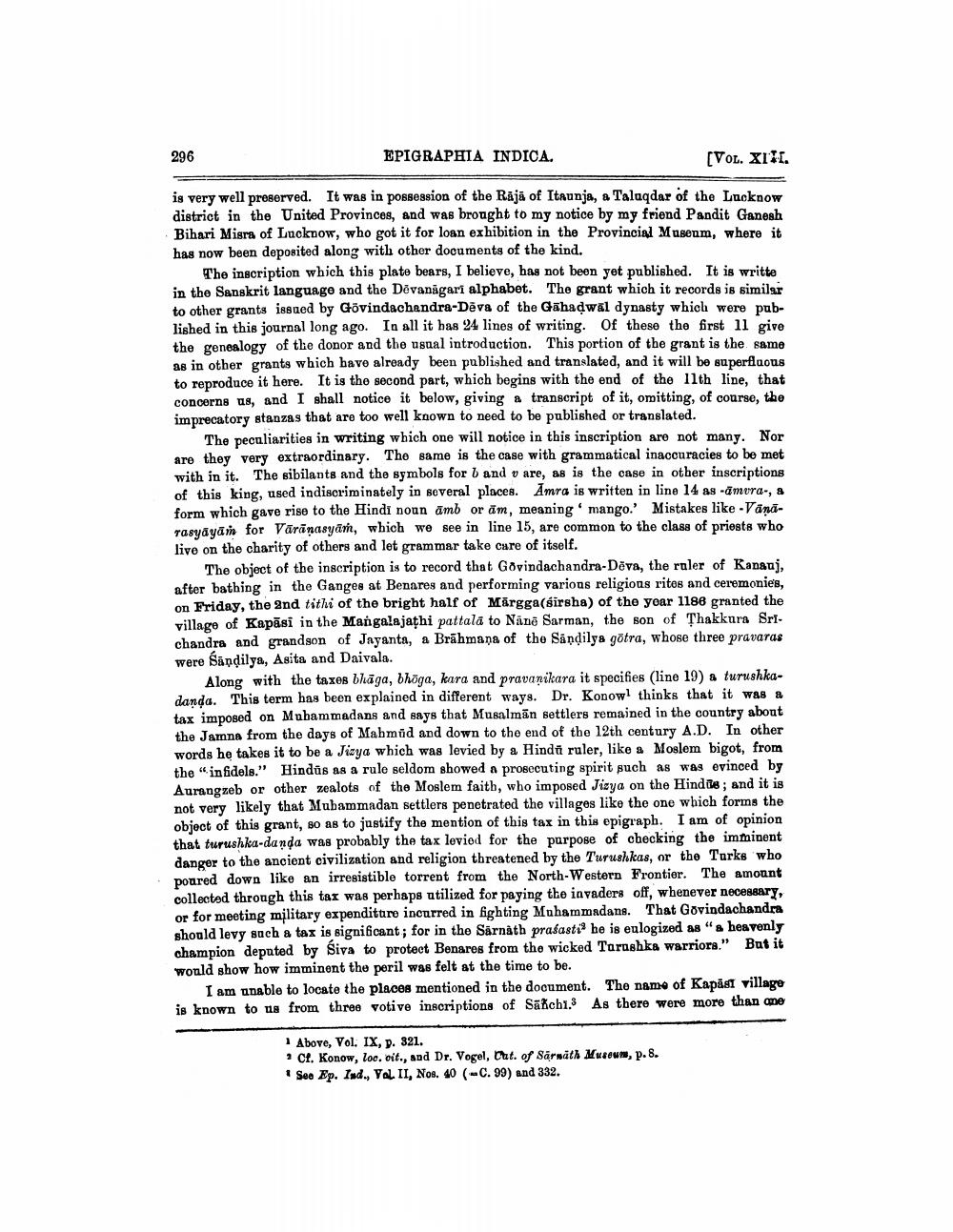________________
EPIGRAPHIA INDICA.
[VOL. XIX.
is very well preserved. It was in possession of the Raja of Itaunja, a Taluqdar of the Lucknow district in the United Provinces, and was brought to my notice by my friend Pandit Ganesh Bihari Misra of Lucknow, who got it for loan exhibition in the Provincial Museum, where it has now been deposited along with other documents of the kind.
296
The inscription which this plate bears, I believe, has not been yet published. It is writte in the Sanskrit language and the Devanagari alphabet. The grant which it records is similar to other grants issued by Govindachandra-Deva of the Gahaḍwal dynasty which were published in this journal long ago. In all it has 24 lines of writing. Of these the first 11 give the genealogy of the donor and the usual introduction. This portion of the grant is the same as in other grants which have already been published and translated, and it will be superfluous to reproduce it here. It is the second part, which begins with the end of the 11th line, that concerns us, and I shall notice it below, giving a transcript of it, omitting, of course, the imprecatory stanzas that are too well known to need to be published or translated.
The peculiarities in writing which one will notice in this inscription are not many. Nor are they very extraordinary. The same is the case with grammatical inaccuracies to be met with in it. The sibilants and the symbols for b and v are, as is the case in other inscriptions of this king, used indiscriminately in several places. Amra is written in line 14 as -amera-, a form which gave rise to the Hindi noun amb or am, meaning mango.' Mistakes like -Vanarasyayam for Varanasyam, which we see in line 15, are common to the class of priests who live on the charity of others and let grammar take care of itself.
The object of the inscription is to record that Govindachandra-Deva, the ruler of Kanauj, after bathing in the Ganges at Benares and performing various religious rites and ceremonies, on Friday, the 2nd tithi of the bright half of Margga(sirsha) of the year 1188 granted the village of Kapasi in the Mangalajathi pattala to Nane Sarman, the son of Thakkura Srichandra and grandson of Jayanta, a Brahmana of the Sandilya götra, whose three pravaras were Sandilya, Asita and Daivala.
Along with the taxes bhaga, bhoga, kara and pravanikara it specifies (line 19) a turushkadanda. This term has been explained in different ways. Dr. Konow1 thinks that it was a tax imposed on Muhammadans and says that Musalman settlers remained in the country about the Jamna from the days of Mahmud and down to the end of the 12th century A.D. In other words he takes it to be a Jizya which was levied by a Hindu ruler, like a Moslem bigot, from the "infidels." Hindus as a rule seldom showed a prosecuting spirit such as was evinced by Aurangzeb or other zealots of the Moslem faith, who imposed Jizya on the Hindus; and it is not very likely that Muhammadan settlers penetrated the villages like the one which forms the object of this grant, so as to justify the mention of this tax in this epigraph. I am of opinion that turushka-danda was probably the tax levied for the purpose of checking the imminent danger to the ancient civilization and religion threatened by the Turushkas, or the Turks who poured down like an irresistible torrent from the North-Western Frontier. The amount collected through this tax was perhaps utilized for paying the invaders off, whenever necessary, or for meeting military expenditure incurred in fighting Muhammadans. That Govindachandra should levy such a tax is significant; for in the Sarnath prasasti he is eulogized as "a heavenly champion deputed by Siva to protect Benares from the wicked Tarashka warriors." But it would show how imminent the peril was felt at the time to be.
I am unable to locate the places mentioned in the document. The name of Kapäst village is known to us from three votive inscriptions of Sanch1.3 As there were more than one
1 Above, Vol. IX, p. 321.
2 Cf. Konow, loc. cit., and Dr. Vogel, Cat. of Sarnath Museum, p. 8. See Ep. Ind., Vol. II, Nos. 40 (C. 99) and 332.




